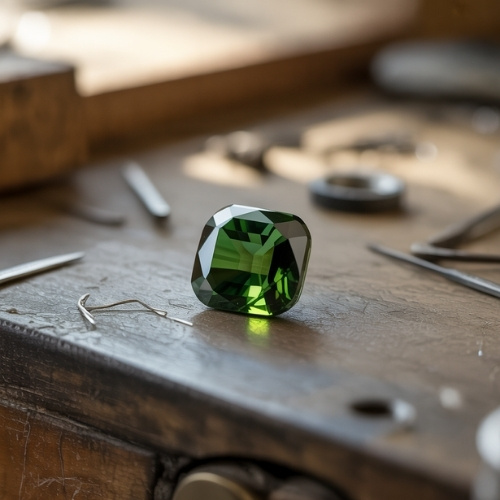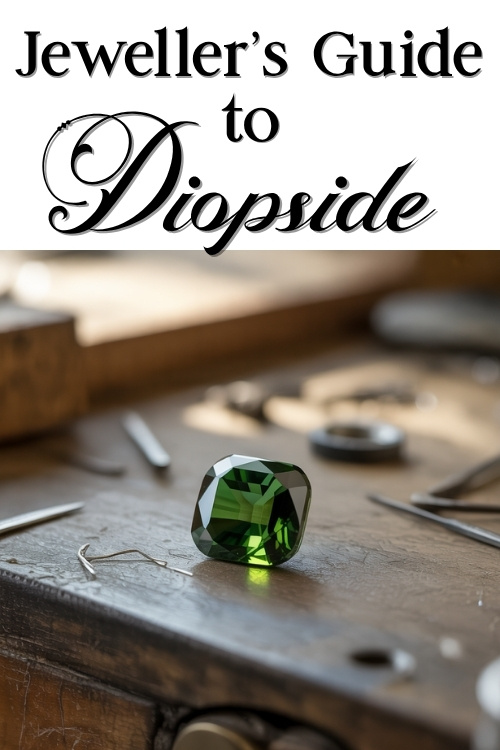Estimated reading time: 5 minutes
Though less famous than emerald or tourmaline, diopside offers jewellers a captivating alternative: natural beauty, often untreated, and full of depth. Its best-known variety, chrome diopside, glows with bottle-green hues that feel both organic and refined. Whether you’re working on a woodland-inspired piece or seeking a gem with earthy presence, diopside is a rewarding gem to explore.
Jump to:
Basic Identification Information
Name & Synonyms
Diopside, Chrome Diopside (when chromium-rich), Siberian emerald (a misleading trade name)
Species
Diopside
Colour Range
Most commonly green, with varieties in black, brown, and rare blue or purple (violane).
Refractive Index
1.665 – 1.730
Birefringence
0.024 – 0.030
Optical Sign
Biaxial +
Pleochroism
Weak to moderate 2 colours
Most visible in darker stones with them typically showing yellowish-green and bluish-green tones.
Specific Gravity
3.22 – 3.40
Fluorescence
Weak to inert
Lustre
Vitreous – It has a glass-like finish when polished
Clarity
Type II
Although eye clean examples are available (usually in smaller sizes), it’s common for diopside to have eye visible inclusions.
Gems Often Mistaken For
Emerald, Green Tourmaline, Tsavorite, Peridot
Mohs Hardness
5.5 – 6
Wearability
Fair
Birthstone
Not a modern or traditional birthstone
Spotting Synthetic (Lab-Grown) Diopside
Lab-grown diopside is not common in the market, but synthetic versions do exist. They can be identified by their lack of typical inclusions. Under magnification, natural inclusions, like needles or feathers, are often present in natural stones but absent in synthetics.
Common Treatments
Diopside is usually untreated, especially the chrome variety, making it an appealing choice for jewellers who prioritise unaltered gems.
Durability & Setting Considerations
Diopside’s beauty comes with some fragility. With a Mohs hardness of 5.5 to 6 and perfect cleavage in one direction, it requires thoughtful handling. Extra care during setting is essential, especially for larger stones, which are more prone to damage. Stones under two carats tend to be more forgiving and easier to set securely, making them a popular choice for practical wear.
Diopside is best when set into low-impact jewellery such as pendants and earrings, but if you do opt to use it in ring designs, protective settings are a must. Bezels and semi-bezels help shield the stone from impact, while low-profile mountings can minimise the risk of catching or snagging. If you opt for a claw setting, rounded or double prongs offer additional support and reduce pressure points.
Chrome diopside’s deep green tone benefits from thoughtful light play. Open-backed settings allow light to pass through and enhance the gem’s internal glow, especially in stones with darker saturation. Pairing diopside with white or reflective metals, such as rhodium-plated silver or white gold, can lift and brighten its appearance beautifully.
🛍️ Explore our selection of pre-owned Diopside Gemstones for your next jewellery creation.
Care Instructions
Cleaning
Avoid ultrasonic and steam cleaners. Instead, use lukewarm water, mild soap, and a soft brush or cloth.
Storage
Keep diopside separate from harder gemstones like sapphire or spinel. Store in a soft pouch or padded compartment to prevent accidental scratching.
Daily Wear
While beautiful, diopside is best suited to mindful or occasional wear. Avoid exposure during chores, exercise, or outdoor work. Earrings and pendants provide safer settings for long-term enjoyment.
Market & Ethical Notes
Chrome diopside is primarily sourced from Siberia, Russia, where harsh winters limit mining to warmer months. Smaller deposits are also found in Pakistan, Finland, and South Africa.
Its market appeal lies in its striking natural colour and rarity in large sizes. Though still relatively affordable, chrome diopside’s unenhanced nature and limited origin make it attractive to collectors and designers alike.
Ethical sourcing is possible through transparent suppliers. As always, ask about mine-to-market practices, especially for Russian-origin stones.
🔗 Learn more about the ethical and environmental story behind Reclaimed and Recycled Gemstones.
Symbolic & Spiritual Meanings
Often associated with emotional healing and inner balance, diopside carries a reputation for encouraging personal growth and intuitive clarity. Its lush green hues resonate strongly with the heart chakra, making it a favoured choice for those seeking to cultivate compassion, openness, and spiritual renewal.
In symbolic jewellery, diopside is frequently used to represent a grounding connection to the natural world. Its forest-toned depths evoke feelings of stability and resilience, while its energetic associations promote insight, learning, and transformation. Whether worn as a personal talisman or offered as a meaningful gift, diopside adds depth and purpose to designs that speak to growth, change, and emotional grounding.
🔗 Dive deeper into Diopside’s Symbolic & Spiritual Meanings
Etymology
The name diopside comes from the Greek dia meaning “through” and opsis meaning “vision” or “sight.” It was named in 1806 by French mineralogist René Just Haüy, referencing its crystal structure and optical properties.
🔗Curious about how diopside was viewed in ancient cultures? Explore its fascinating myths and legends
📌 Save this jeweller’s guide to diopside for quick reference next time you’re working with this stunning gem.


